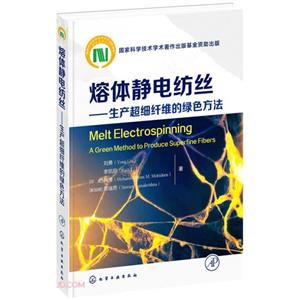-
>
湖南省志(1978-2002)?铁路志
-
>
公路车宝典(ZINN的公路车维修与保养秘籍)
-
>
晶体管电路设计(下)
-
>
无头案:雍正暴亡之谜
-
>
基于个性化设计策略的智能交通系统关键技术
-
>
花样百出:贵州少数民族图案填色
-
>
识木:全球220种木材图鉴
熔体静电纺丝 生产chao细纤维的绿色方法 版权信息
- ISBN:9787122397997
- 条形码:9787122397997 ; 978-7-122-39799-7
- 装帧:一般胶版纸
- 册数:暂无
- 重量:暂无
- 所属分类:>>
熔体静电纺丝 生产chao细纤维的绿色方法 本书特色
随着纳米新材料科技的持续发展,高分子基纳米复合纤维在燃料电池、锂电池、太阳能电池、水过滤、空气过滤、血液过滤、组织工程、载药缓释、癌症检测、介入治疗支架、人造血管、金属吸附等领域得到了广泛研究。静电纺丝作为制备纳米纤维简单、直接、有效的方法,在国内外得到了普遍重视和广泛研究。其中熔体静电纺丝,相对于得到广泛普及的溶液静电纺丝来说,因不使用挥发性有机溶剂而具有经济、安全、绿色环保等特点。本书为作者带领课题组成员多年来对熔体静电纺丝设备、原理及技术方法进行探索的成果总结,是原创性英文专著。 本书特点:1. 作者知名。刘勇教授(北京化工大学材料学院高分子纳米复合材料实验室负责人)和新加坡工程院Seeram Ramakrishna院士(静电纺丝技术制备纳米纤维领域世界公认的领导者和开拓者,也是英国皇家工程院外籍院士、印度国家工程院院士,东盟工程技术院院士)的团队,是近年来熔体静电纺丝领域活跃和成果丰富的研究团队。 2. 内容原创。基于作者多年的原创科研成果,对熔体静电纺丝技术做了全面的总结。 3. 技术内容全面。介绍了熔体静电纺丝的发明,包括离心熔体静电纺丝和向上熔体静电纺丝。阐述了优化技术、聚合物熔体静电纺丝、测试方法、耗散粒子动力学模拟和改进方法。 4. 思路创新。提供了一个对当代静电纺丝研究及其许多潜在应用的有益的和独特的介绍。
熔体静电纺丝 生产chao细纤维的绿色方法 内容简介
熔体静电纺丝是纳米纤维制造的新兴技术之一,其**的特点是不用添加溶剂,具有无毒、环保、安全、经济等方面的优势。在生物医学、药物控释、组织工程等方向具有广阔的应用前景。本书基于作者多年的原创科研成果,对熔体静电纺丝技术做了全面的总结,共四部分。**部分介绍了熔融静电纺丝的发明,包括离心熔融静电纺丝和向上熔融静电纺丝的独立发展。分别对两种方法的产率和纤维直径进行了优化。第二部分介绍了熔融体的静电纺丝以及利用不同聚合物和自行设计的装置测试纤维性能的方法。第三部分介绍耗散粒子动力学模拟。这种模拟技术是模拟纺丝过程中分子链结构和取向的一种方法。第四部分介绍了离心熔融静电纺丝的原理、方法及改进措施。 本书不仅适合静电纺丝研究的广大科研人员阅读,同时还可供燃料电池、锂电池、太阳能电池、水过滤、空气过滤、血液过滤、组织工程、载药缓释、癌症检测、介入治疗支架、人造血管、金属吸附等可能用到纳米纤维的广大领域的科技工作者、研究生、企业管理人员参考。
熔体静电纺丝 生产chao细纤维的绿色方法 目录
Preface
Acknowledgments
1.Development of melt electrospinning: the past, present, and future
1.1 Electrospinning
1.2 The working principle of electrospinning
1.3 Types of electrospinning
1.4 Solution electrospinning
1.5 Melt electrospinning
1.6 The scope of this book
References
2.The device of melt electrospinning
2.1 Introduction
2.2 Conventional melt electrospinning devices
2.3 Laser heating melt electrospinning devices
2.4 Screw extrusion melting electrostatic spinning devices
2.5 Electromagnetic spinning devices for vibration
2.6 Air melt electrospinning devices
2.7 Coaxial melt electrosplnning devices
2.8 Upward melt electrospinning devices
2.9 Centrifugal melt electrospinning devices
2.10 Conclusion
References
3.Formation of fibrous structure and influential factors in melt electrospinning
3.1 Polycaprolactone
3.1.1 Experiment
3.1.2 Results and discussion
3.2 Polylactic acid (PLA)
3.2.1 The diameter of PLLA fiber under a pulsed electric field
3.2.2 Thermal degradation of PLA fiber
3.2.3 The relative molecular mass of PLA fibers
3.2.4 Orientation and crystallinity of the PLA fiber
3.3 Phenolic resin
3.3.1 Materials and equipment
3.3.2 Orthogonal experimental arrangements
3.3.3 Optimal spinning conditions
3.3.4 Fiber heat resistance and crystallinity
3.3.5 Session conclusion
3.4 Polypropylene (PP)
3.4.1 Equipment
3.4.2 Effect of collecting plate on spinning electric field
3.4.3 Effect of upper plate on spinning electric field
3.4.4 Effect of the hyperbranched polymers
3.4.5 Effect of polar additive on PP
3.5 Conclusion
References
Further reading
4.Melt electrospinning in a parallel electric field
4.1 Introduction
4.2 Method and experiments
4.2.1 Experimental material
4.2.2 Parallel electrospinning equipment
4.2.3 Finite element modeling
4.2.4 Theoretical analysis
4.3 Results and discussion
4.3.1 Experimental electrospinning in a parallel electric field
4.3.2 Finite element simulation of the electrospinning process in a parallel electric field
4.4 Conclusion
References
5.Dissipative particle dynamics simulation on melt electrospinning
5.1 Introduction
5.2 Differential scanning calorimetry simulation under different electric fields
5.2.1 Electrostatic field
5.2.2 Pulsed electric field
5.3 Conclusion
References
6.Experimental study on centrifugal melt electrospinning
6.1 Overview of centrifugal melt electrospinning
6.2 Research progress of centrifugal melt electrospinning at home and abroad
6.3 The significance of centrifugal melt electrospinning devices
6.4 Experimental study on centrifugal melt electrospinning
6.4.1 Experimental section
6.4.2 Characterization method
6.4.3 Results and discussion
6.5 Innovative design of centrifugal melt electrospinning devices
6.6 Conclusion
References
7.Dissipative particle dynamics simulations of centrifugal melt electrospinning
7.1 Introduction
7.2 The dissipative particle dynamics model in centrifugal melt electrospinning
7.3 Different electric field simulation of centrifugal melt electrospinning
7.3.1 Centrifugal melt electrospinning in an electrostatic field
7.3.2 Centrifugal melt electrospinning in a pulsed electric field
7.4 Conclusion
References
8.Three-dimensional (3D) printing based on controlled melt electrospinning in polymeric biomedical materials
8.1 Introduction
8.2 Basic principles of 3D printing based on electrospinning
8.3 Different auxiliary electrode and dielectric plate collectors
8.3.1 Setup for electrospinning with an electrostatic lens system
8.3.2 Dielectric plate with sharp-pin electrode
8.4 Patterned, tubular, and porous nanofiber
8.5 Conclusion
References
熔体静电纺丝 生产chao细纤维的绿色方法 作者简介
Yong Liu(刘勇) is all associate professor of theCollege of Materials Science and Engineering at Beijing University of ChemicalTechnology(BUCT).He is a director of thepolymeric Nano Composite group at BUCTHe received his Ph.D.from the Institute ofChemistry,Chinese Academy of Science,in2005.PrOf.LiU worked as a visiting associate professor at Cornell University in2011—2012.He had committed hisresearch work to an project,as a post。doctoral researcher in Tsinghua University for more than 2 years.He is currently supervising mastersinternational PH.D.sutdents,and postdoctoral fellows.His research interest is focused on the application of highpertbrmance engineering plastics,performance advancement of rubber products,spinning of special functional fibers,preparation of nanofibers by electro’spinning.decomposing formaldehyde in the dark and at room temperature,preparation of membranes for fuel cells especially in polymer electrolytemembrane(PEM)fuel cells,and the application and preparation of nano‘particles.He has published 103 articles in peer—reviewed journals and presentedabout 47 oral and poster presentations in national and international journals·Prof.Liu has applied for 83 patents,of which 47 are currently issued.He servesas a reviewer for more than 40 joumals such as Polymer,RSC Advances,Polymeric Engineering and Science,Journal of Applied Polymer and Science.Dr.Prof.LiuiSamemberoftheRoyalSocietyofChemistry,a seniormemberofthe Chinese Society for Composite Materials,a member of the American Chemical Society,and a member of the Chinese Chemical Society.He wasawarded by the State Council,with the National Award for Science and Technology Progress(Grade 2),for his contribution to polymer materials science.As a famous scientist in nanofibers.he has been interviewed by and appeared on CCTV BTV,Dragon TV,and many other television programs and In newspaper articles.
- >
自卑与超越
自卑与超越
¥13.5¥39.8 - >
名家带你读鲁迅:朝花夕拾
名家带你读鲁迅:朝花夕拾
¥10.5¥21.0 - >
罗庸西南联大授课录
罗庸西南联大授课录
¥18.6¥32.0 - >
中国人在乌苏里边疆区:历史与人类学概述
中国人在乌苏里边疆区:历史与人类学概述
¥32.9¥48.0 - >
伊索寓言-世界文学名著典藏-全译本
伊索寓言-世界文学名著典藏-全译本
¥6.1¥19.0 - >
史学评论
史学评论
¥17.2¥42.0 - >
我从未如此眷恋人间
我从未如此眷恋人间
¥16.4¥49.8 - >
龙榆生:词曲概论/大家小书
龙榆生:词曲概论/大家小书
¥9.1¥24.0
-
化工原理
¥21.5¥50 -
化工原理
¥30.6¥39.8 -
化工原理
¥58.7¥69 -
2022图书×抽奖盲袋
¥9.9¥25 -
2023读书月阅读盲盒——天黑,闭眼,刀谁?
¥42.3¥158















